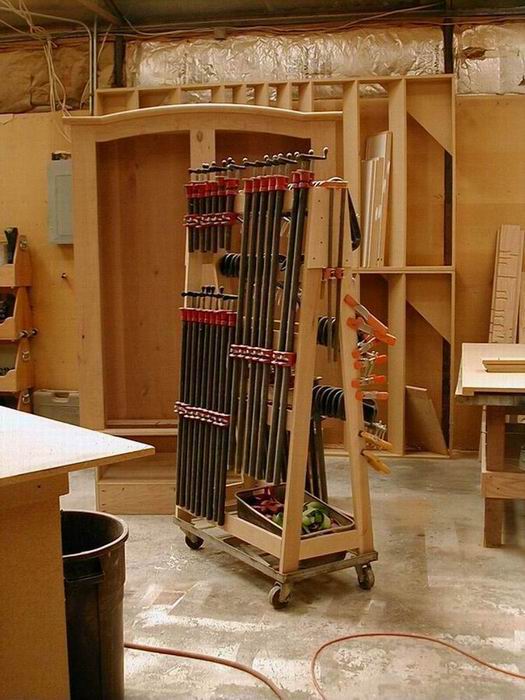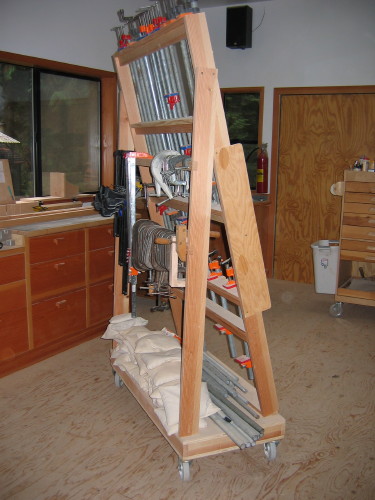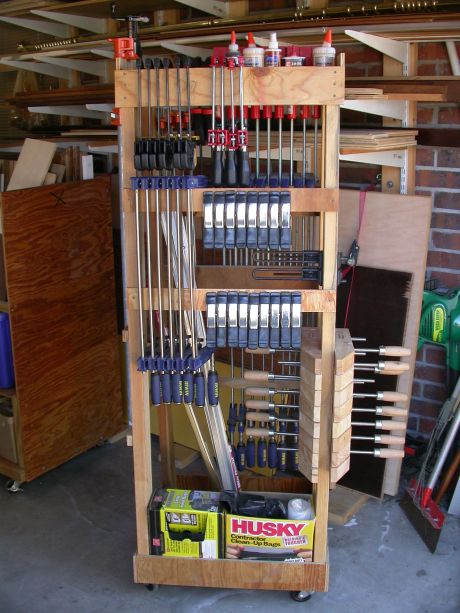Question
I want to take my considerable collection of clamps off the wall and put them on a cart so we can move them to the work rather than lugging clamps back and forth. Has anyone built such a cart? What did you do right? What would you have done differently? Drawings or photos would also be much appreciated.
Forum Responses
(Cabinetmaking Forum)
From contributor G:
We use an old shopping cart. It has worked quite well for a number of years for pipe clamps. You can find one at any salvage yard.


Comment from Sam Rogers:
In addition to the images below, here is some information about how I made my clamp cart. Included are the Materials and Cut List and also the Tool Setup.
| Item | Qty | Component | L | W | D | Material | Notes |
| A | 1 | Base | 24" | 24" | " | Plywood * | |
| B | 2 | Base support | 24" | 5" | " | Plywood * | used to stiffen base |
| C | 4 | Base siding | 24" | 4" | " | Plywood * | cut long to trim miters |
| D | 4 | Frame boards | 5' 6" | 4" | 2" | Pine | just dimensional lumber |
| E | 2 | Top support | 24" | 4" | " | Plywood * | |
| F | 4 | Casters | 3" | Polyurathane | |||
| G | 16 | Pan head screws | " | Stainless | #14 |
** Notes **
1. Plywood is 3/4" or 1/2" Baltic Birch
2. Everything else used for this project is all scrap, at least for me.
Tool Setup
Set your sliding T-bevel...
First things first: Clamps are heavy! If one tries to keep this thing square to the base, by the time the clamps are loaded, it will simply fall over. Setting an angle on the frame boards drives the head weight of the clamps to the center of the cart. The steeper the angle, the more the weight approaches the center and the more stable it becomes.
So, grab a sliding T-bevel and set it to 5°. This is an arbitrary setting and it could just as easily be 7° or 10°. Even at just 5°, one can see from the picture at left how quickly the frame boards will slope away from the edge of the base over a 6' run. Just remember that as the angle increases, the tops of the frame boards will be driven closer to each other. And, for every degree of angle increase, cart stability will certainly increase as well. But, increasing the angle may also mean that either the base size or length of the frame boards will have to be adjusted accordingly to compensate. Regardless of the angle you use, set your T-bevel and lock it in. You'll be using the T-bevel for tool setup on the table and miter saws throughout the project. We'll be using 5° for the remainder of the project detail.


"The images in this article are provided by Sam Rogers. To see all of the steps to completing this project, visit his Clamp Cart link. Many thanks to Sam for his contribution to WOODWEB'S Knowledge Base.